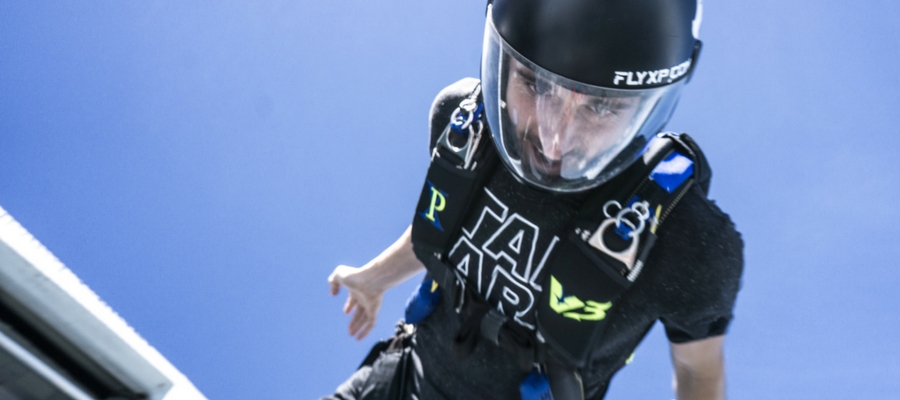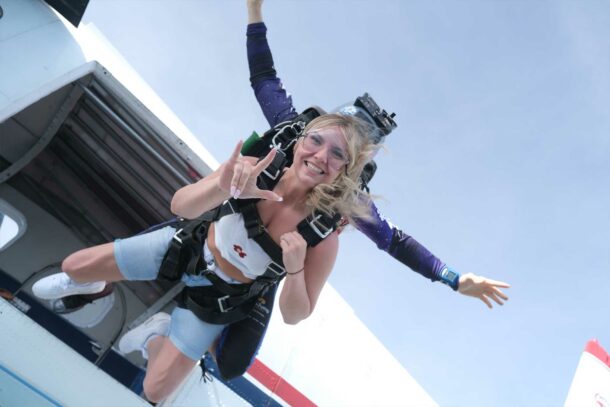Confident vs. Cocky in Skydiving
Thursday, October 12, 2017
Confident vs. Cocky in Skydiving?
In skydiving, we often hear, “be confident, not cocky” when making decisions. There’s such a fine line between the two in this high-speed sport, so we thought we’d break it down by looking at some examples of actual accounts that we can learn from.
The United States Parachute Association lays down Basic Safety Requirements [BSR] in the Skydiver Information Manual. The BSR’s are the only guiding force behind the USPA in the sport. Other guiding forces are what individual skydiving centers impose, which may be different, usually more strict, than what the USPA recommends.
The following responses to each example are derived from experts who have spent years in the sport and have made several thousands of skydives. Hence, the “Expert Opinion” on the following examples.
DEFINITIONS:
- Confidence: “1) full trust; belief in powers, trustworthiness, or reliability of a person or thing; 2) belief in oneself and one’s powers or abilities; self-confidence; self-reliance; assurance” ?
- Cocky: “arrogant; pertly self-assertive; conceited”

Photo credit (above): Keith Creedy
Example 1:
An AFP student on their second level tells their instructor they’re ready to do a diver exit without the instructor holding on.
**EXPERT OPINION**
The Advanced Freefall Program [AFP] at Skydive Carolina is an extensive program designed to introduce new skills at a certain level; provided that students have successfully demonstrated the skills necessary on the previous level. Since every student learns and progresses differently, the program is then tailored to meet the needs of that student.
The AFP program introduces the first solo exit on Level 4 (that may not necessarily mean the fourth jump in the program. If the student doesn’t meet the requirements of a certain level, they may have to repeat a jump). A student asking an instructor to do more advanced exits without knowing the fundamentals of the exit and body position out the door has a cocky attitude. It’s great that they have self-confidence, however, skydiving is a dangerous sport and it is the instructor’s duty to guide a student through a safe progression.
It’s easy to want to hurry up and do all of the cool stuff, but trust that your instructor is helping you to build a solid foundation. Take your time and absorb all you can from your instructors.
Example 2:
A licensed skydiver saw a recent world record skydive and was inspired to get on the next one. That jumper trained in the tunnel with a coach, attended many camps, and showed up to the event feeling ready to perform.
**EXPERT OPINION**
World Records ARE inspiring! It’s how many skydivers stayed in the sport by reaching an incredible goal. World Records require a lot of hard work, time in the sport, and money. The dedication of getting coached, doing tunnel training, and going to camps, and building skills are a recipe for success. Humility of taking this path and feeling prepared should form confidence.
Example 3:
A B-licensed jumper earned their license under a 210 square foot canopy weighing in at 195. That jumper has made about 10 jumps a month and recently bragged to his friends that he just bought a 170 square foot parachute.
**EXPERT OPINION**
High-performance canopy piloting (aka “swooping”) is sexy and a lot of skydivers are attracted to it. However, to advance to this level requires a lot of training with a slower progression as it takes more time to build up knowledge and experience.
Downsizing is a HOT TOPIC and has been a growing concern for the last TWO DECADES! Any jumper with little experience talking about downsizing quickly is a red flag situation and typically a result of overconfidence. But don’t just take our word for it! Here are several other articles discussing this problem with solutions, cautions, and experience.
- http://www.dropzone.com/safety/Canopy_Control/When_Should_You_Upsize_Your_Canopy_1009.html
- http://www.performancedesigns.com/docs/survival.pdf
- http://www.uspa.org/Portals/0/files/misc_sdriskquotient.pdf
- https://www.youtube.com/watch?v=5w1EomZlAds
- http://www.bigairsportz.com/pdf/bas-sizingchart.pdf
- http://www.performancedesigns.com/docs/choosing1.pdf
Example 4:
A professional skydiver organizing at a boogie was jumping with a group of four. The group ranged in experience from 100 jumps to 500 jumps. The group was on a twenty-minute call when the organizer saw that the winds were 15 mph with gusts up to 25 mph. The organizer felt comfortable with the winds, talked to the group and they decided not to jump.
**EXPERT OPINION**
Although the organizer, a presumably experienced jumper, was ok to jump in the high winds, they decided to discuss the weather conditions and concerns with their group. First, the organizer was incredibly aware of the conditions, and bringing it to the group was wise so they didn’t put themselves in a situation that was above their skill level. The fact that the organizer stood down from the jump and stayed with their group showed an incredible amount of confidence. This sort of decision making helps others make good decisions.
Example 5:
A C-licensed jumper just completed their First Flight Wingsuit Course in the spring. This jumper only makes about 15 to 20 skydives a month and talks about BASE jumping with a used Squirrel Freak suit that summer.
**EXPERT OPINION**
BASE jumping is a dangerous sport. Wingsuit (proximity flying) BASE jumping is probably the most dangerous sport in the world. Skydive Carolina is not anti-BASE but highly suggests that anyone interested in BASE jumping seek out professional courses and continue mentorship for a long period of time. Skydive Carolina does not train BASE jumping and has no opinion on that sport, other than to proceed with extreme caution.
In order to progress in wingsuit flying, a similar course of action like downsizing parachutes needs to occur. There are dozens of different kinds of wingsuits based on skill level and experience. The above scenario is a red flag to a cocky attitude – someone with not a lot of skill in skydiving nor wingsuit training and talking about a VERY advanced suit BASE jumping, not even knowing their BASE skills, are the tell-tale signs of warning.
Important Takeaways
Many veteran skydivers have either watched or experienced making bad decisions getting a good scare, breaking themselves, or worse, having a friend, DZ local, or pro go in. In skydiving, the boundaries are often blurred between being cocky or confident.
The important takeaways between the two are that confident skydivers make wise decisions, often erring on the side of caution. Confident skydivers have gotten coaching, are aware, put their time (in years) into the sport to build skill, and build extensive experience. Confident skydivers help others make good decisions. One professional skydiver said, “I have 11,000 jumps because I’ve said no to a lot of jumps and I’ve helped others do the same.”
It’s easy to watch all the rad videos of cool jumps and BASE jumping and want to rush to get a cool video of yourself. What’s hard to convey in those videos – is all the massive experience that those professionals and seasoned veterans built up to reach that point in their careers. If we are going to emphasize something in this article – it would be to get coaching, take your time, and make wise decisions. Be confident, not cocky.
“The most deadly aspect of skydiving isn’t swooping, wingsuiting, big ways or collisions or whatever you think it is. It’s a lack of patience.”
Copyright © 2024, Skydive Carolina, All Rights Reserved.
DropZone Web Design & Marketing by Beyond Marketing, LLC





